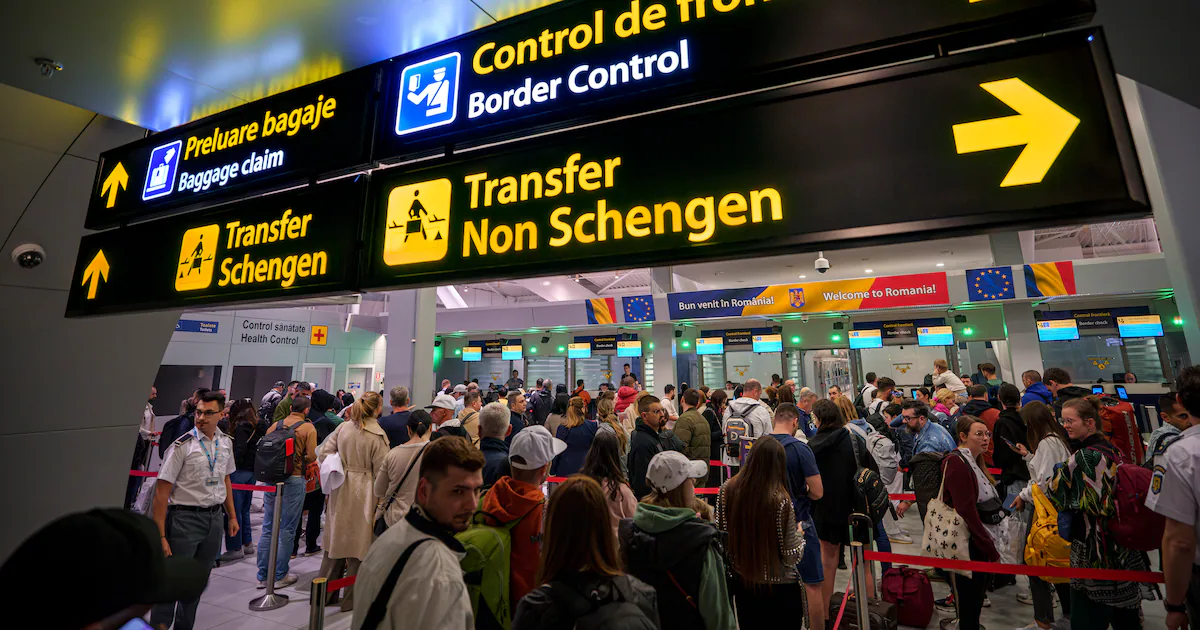
Next month, the European Union will roll out an automated biometric program for foreign travelers entering nearly 30 countries.
Scheduled to start Oct. 12, the Entry/Exit System (EES) will replace traditional passport procedures, including the coveted stamp, with facial imaging and fingerprinting.
The EES will be phased in over six months, with the 29 countries in the Schengen area expected to be fully compliant by April 10. The destinations include top tourism draws such as Italy, Greece, France and Spain.
According to a July announcement by the European Council, some countries may switch over to biometrics early in the process. Others may slowly integrate the technology, reverting to the older procedures during particularly busy times. During the transition, the countries will continue to stamp passports, the last chance for travelers to acquire the globe-trotting badge.
“There’s one sentimental reason this matters,” said Robyn Stencil, program manager of Rick Steves’s tour program. “There’s probably not going to be any more stamps in your passport.”
– – –
A faster way to clear customs
The technological advantages outweigh the nostalgia factor, Europe travel experts say.
Though waits could be a bit longer as the countries work out the kinks, the high-tech, contactless program could eventually save travelers significant time. Upon arrival, first-time users of the new program will register at an immigration booth or free-standing kiosk that will collect their fingerprints, snap their photo and scan their passport. If all goes well, they are free to enter. Children younger than 12 will not have to provide fingerprints.
“Instead of having to get in line, wait to be seen by an immigration officer, have them go through your passport and then stamp the passport, you’re going to use self-service scanning machines,” she said. “The end result will be a much more efficient border process.”
The E.U. cited expediency and efficiency at border checks and crossings as key reasons for the change. Increasing security in the Schengen area and curbing “irregular migration” were also motivating factors.
Liam S. Dunch, global group product manager for Europe at Abercrombie & Kent, the luxury travel operator, said biometrics data will help the E.U. better track tourists’ stays, including visitors who may exceed the legal number of days.
“Because there was no centralized electronic tracking system, they’ve never really been able to know if people were overstaying their entries in Europe,” Dunch said. “Now, everyone will be registered in a central database. If you stay past the 90 days in the 180-day period, there will be consequences.”
– – –
Privacy concerns for travelers
The E.U.’s leap into biometrics is part of a growing trend in travel security. Earlier this summer, the Transportation Security Administration unveiled PreCheck Touchless ID lanes at 15 airports, with four airlines participating. The system uses facial recognition to verify the identity of eligible travelers, dispensing with driver’s licenses and other forms of ID. Customs and Border Protection, meanwhile, utilizes the technology for passengers entering and exiting more than 230 airports.
For people protective of their privacy, the intrusive nature of biometrics can be unsettling. According to the E.U., the new system will collect, record and store data found in your travel documents, such as:
• Full name and date of birth
• The date and place of your arrival and departure
• Your facial image and fingerprints
• Whether you were denied entry
The biometric data may be stored for up to five years in some cases.
The E.U. said only “specific staff within national authorities” can access the data, such as border, visa and immigration officials and law enforcement in the EES countries. For the most part, third parties cannot obtain your data, it stated.
Rich Davis, a senior security adviser with International SOS, a security risk assessment firm, said privacy protections in Europe are high and even more stringent than the ones in the States. The E.U.’s General Data Protection Regulation, which went into effect in 2018, is a comprehensive and rigorous law that safeguards individuals’ privacy rights. Violators could face penalties in the tens of millions of euros.
“The data will be stored in compliance with the European Union’s privacy laws,” Davis said. “The E.U. oversees the users of travelers’ data and says you must comply and protect this.”
Unfortunately, Europe-bound visitors uncomfortable with biometrics can’t opt out and request a manual passport check instead.
“If somebody wants to go to Europe, they are going to have to submit their biometrics,” Stencil said. “If they choose not to, then they are choosing not to travel to Europe.”
– – –
After EES comes ETIAS
Once EES is up and running, the E.U. will launch the European Travel Information and Authorization System (ETIAS), the long-delayed second phase of its grand plan. The E.U. has not announced a specific start date, but said it would give several months’ notice before its launch. Its website says it is slated for the last quarter of 2026.
The authorization program is similar to the United Kingdom’s Electronic Travel Authorization, which applies to U.S. citizens, and the United States’ Electronic System for Travel Authorization, which will increase from $21 to $40 on Sept. 30.
For the ETIAS, citizens of nearly 50 visa-exempt countries, such as the United States, Canada and Australia, must apply to enter 30 European countries (the Schengen 29, plus Cyprus). It is valid for three years or until your passport expires, whichever comes first.
Travelers apply through the ETIAS website or app. The cost is 20 euros, but the amount could change – again. Visitors of all ages require the authorization, but minors under the age of 18 and seniors older than 70 are exempt from paying. Visitors must apply in advance – don’t wait till you’re the gate.
The E.U. said applications will be processed within minutes to 96 hours, but recommends people procure it before booking their airfare and hotels. In some cases, officials may require additional information or an interview, which could lengthen the process by an extra 30 days.
The ETIAS will be linked to your passport, so don’t leave your book at home. (You’ll still need it to check into your hotel, rent a car and receive your value-added tax back.) Dunch said the transportation providers – the airlines, cruise lines, bus companies – will be responsible for checking and can deny you boarding if you don’t comply.
During the six-month transition period, the Schengen zone will excuse travelers who show up without it. Stencil said travelers will also receive a pass during a subsequent six-month grace period. After that, if they arrive without one, they could be deported.
When purchasing an ETIAS, make sure to use the official website, regardless of which country you plan to visit. Dunch said when the E.U. announced the new program, many impostors started popping up, offering to help visitors for an exorbitant amount.



